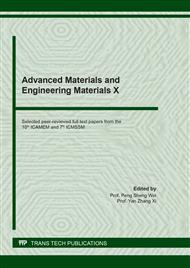p.237
p.243
p.250
p.255
p.260
p.268
p.277
p.282
p.287
Experimental Study of Tool Wear when Milling Tropical Wood with Various Tool Materials
Abstract:
The paper presents a study on the performance of cutter tip for wood milling process. The tests were performed with the tropical wood samples which were milled in the double sided wood planer, the measured micro-geometrical parameters encompassing the linear wear and tooltip radius. The study primarily contributes to developing a far better understanding of the physical nature of cutting tool wear in response with the growing concern of many researchers. Given this basis, it does not only assist the selection of reasonable cutting tool but also enable the detection of the patterns in the cutting tool wear process. In terms of tool wear and bluntness, there has been a number of researches taking account into the physical nature of cutting tools, - providing basis for selection of cutting tools apart from clarification of the current pattern of tool wear and bluntness. The load applied to the cutter during wood milling is the load that changes marks periodically. When starting to work after tool sharpening and finishing, the first stage changes the microscopic geometry - tool run-in process (rapid initial wear), followed by constant conditions of wear before a rapid wear which leads to failure at last. The objective of this study is to determine the influence of the cutting path to the tooltip radius and linear wear of the cutting edge. The paper employs method of least squares and variance analysis in application of the Minitab software to determine regression equations for relation of the tooltip radius and linear wear to the relative cutting length. The ultimate goal is to predict the life of cutting tool when milling tropical wood.
Info:
Periodical:
Pages:
260-267
Citation:
Online since:
November 2021
Authors:
Price:
Сopyright:
© 2021 Trans Tech Publications Ltd. All Rights Reserved
Share:
Citation:


